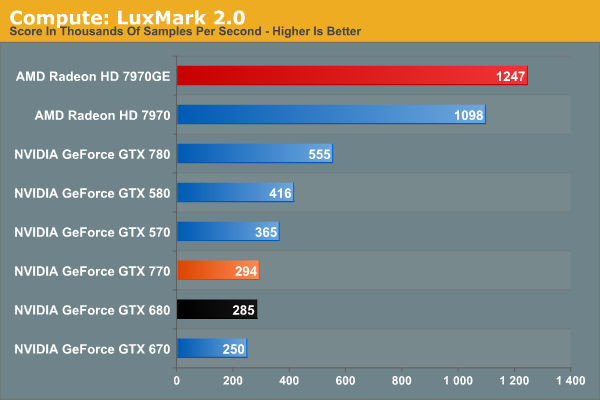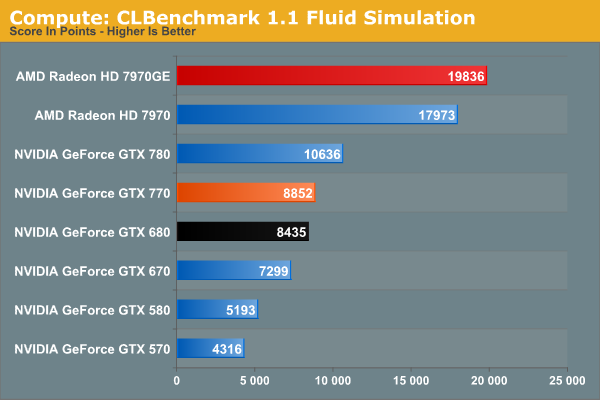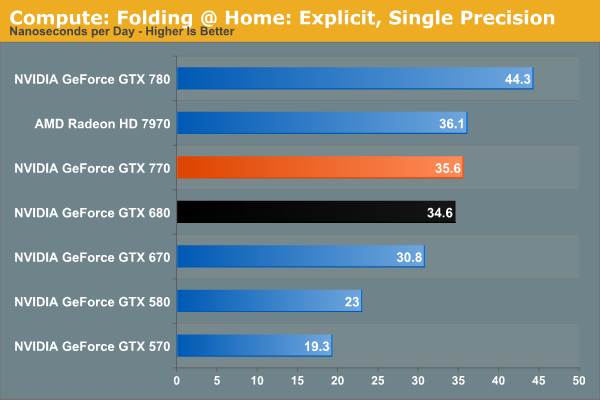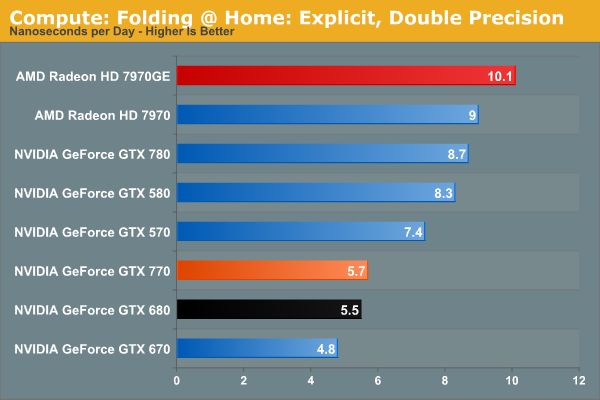NVIDIA GeForce GTX 770 Review: The $400 Fight
by Ryan Smith on May 30, 2013 9:00 AM ESTCompute
Jumping into compute, we aren’t expecting too much here. Outside of DirectCompute GK104 is generally a poor compute GPU, and other than the clockspeed boost GTX 770 doesn’t have much going for it.
As always we'll start with our DirectCompute game example, Civilization V, which uses DirectCompute to decompress textures on the fly. Civ V includes a sub-benchmark that exclusively tests the speed of their texture decompression algorithm by repeatedly decompressing the textures required for one of the game’s leader scenes. While DirectCompute is used in many games, this is one of the only games with a benchmark that can isolate the use of DirectCompute and its resulting performance.

Civilization V at least shows that NVIDIA’s DirectCompute performance is up to snuff in this case. Though as is the case with GTX 780, we’re reaching the limits of what this benchmark can do, due to just how fast modern cards have become.
Our next benchmark is LuxMark2.0, the official benchmark of SmallLuxGPU 2.0. SmallLuxGPU is an OpenCL accelerated ray tracer that is part of the larger LuxRender suite. Ray tracing has become a stronghold for GPUs in recent years as ray tracing maps well to GPU pipelines, allowing artists to render scenes much more quickly than with CPUs alone.

Moving on to a more general compute task, we get a reminder of how poor GK104 is here. GTX 770 can beat the slower GK104 products, and that’s it. Even GTX 570 is faster, never mind the massive lead that 7970GE holds.
Our 3rd benchmark set comes from CLBenchmark 1.1. CLBenchmark contains a number of subtests; we’re focusing on the most practical of them, the computer vision test and the fluid simulation test. The former being a useful proxy for computer imaging tasks where systems are required to parse images and identify features (e.g. humans), while fluid simulations are common in professional graphics work and games alike.


CLBenchmark paints GTX 770 in a better light than LuxMark, but not by a great deal. The gains over the GTX 680 are miniscule since these benchmarks aren’t memory bandwidth limited, and the gap between it and the 7970GE is nothing short of enormous.
Moving on, our 4th compute benchmark is FAHBench, the official Folding @ Home benchmark. Folding @ Home is the popular Stanford-backed research and distributed computing initiative that has work distributed to millions of volunteer computers over the internet, each of which is responsible for a tiny slice of a protein folding simulation. FAHBench can test both single precision and double precision floating point performance, with single precision being the most useful metric for most consumer cards due to their low double precision performance. Each precision has two modes, explicit and implicit, the difference being whether water atoms are included in the simulation, which adds quite a bit of work and overhead. This is another OpenCL test, as Folding @ Home has moved exclusively to OpenCL this year with FAHCore 17.


Recent core improvements in Folding @ Home continue to pay off for NVIDIA. In single precision the GTX 770 is just fast enough to hang with the 7970 vanilla, though the 7970GE is still over 10% faster. Double precision on the other hand is entirely in AMD’s favor thanks to GK104’s very poor FP64 performance.
Wrapping things up, our final compute benchmark is an in-house project developed by our very own Dr. Ian Cutress. SystemCompute is our first C++ AMP benchmark, utilizing Microsoft’s simple C++ extensions to allow the easy use of GPU computing in C++ programs. SystemCompute in turn is a collection of benchmarks for several different fundamental compute algorithms, as described in this previous article, with the final score represented in points. DirectCompute is the compute backend for C++ AMP on Windows, so this forms our other DirectCompute test.

Unlike our other compute benchmarks, System Compute is at least a little bit memory bandwidth sensitive, so GTX 770 pulls ahead of GTX 680 by 11%. Otherwise like every other compute benchmark, AMD’s cards fare far better here.










117 Comments
View All Comments
djboxbaba - Thursday, May 30, 2013 - link
I'd say thats a good choice for the 1440p monitor. As far as the actual card, I agree with you that your decision should be between those 2 cards. Just as performance of the 7970GHz has increased due to driver updates, I think we can expect some performance increase from the 770 over time as well. Not sure why that was not mentioned at all in the article. If i were in your situation it would probably come down to the bundled games that come with the AMD card, do you want those games?yasamoka - Thursday, May 30, 2013 - link
No, we cannot expect performance increases from the 770 over time due to driver updates. The 770 is GK104, same architecture as the GTX680. It's just a higher-clocked 680. 680 drivers have been rolling since its release in March, it's been 14 months.The regular game-specific performance improvements will be there for both cards, for games that are coming, but we can't expect the 770 to improve in performance due to drivers as it is already a 14-month mature product (refresh), driver-wise.
EJS1980 - Thursday, May 30, 2013 - link
That makes no sense. If the 7970 has been benefiting greatly from each driver update, and its almost 6 months older than GK104, why can the 7970 improve but the 770 can't?Galidou - Saturday, June 1, 2013 - link
Wow that's a real lack of information to come up with an answer like this. 7970 was a COMPLETE remake of what had been done before. Totally justifiable that drivers improved performance like the gtx 600 series that was new. The 770 is TOTALLY a 680, physically, it's simply a GK 104 die pushed to the extreme, almost nothing new on the driver side from 680 to 770. Not that they can't improve anything but most of the job is done on the driver side of things.Stuka87 - Thursday, May 30, 2013 - link
Did you mean to say 7970Ghz? The 7950 is already at $300, has been for some time.joel4565 - Thursday, May 30, 2013 - link
Yeah I did mean 7970Ghz. Sorry for confusion.EJS1980 - Thursday, May 30, 2013 - link
I'd say forget the Dell, and go with an Overlord Tempest OC. It's the same price & panel as you'd get from Dell, except it can be overclocked to 120hz. They're a California based company, and their sales/IT departments are awesome. If you're not interested in overclocking, they sell a 60hz model for about $400. You should seriously check them out.cbrownx88 - Friday, May 31, 2013 - link
I went to their page and everything is sold out... :(Hrel - Thursday, May 30, 2013 - link
Pretty happy to see Nvidia FINALLY realize the potential of this architexture. Gives me hope for the next generation; combined with a process node drop we should see pretty impressive performance. This refresh will keep the market feeling fresh until then. I just hope they're a lot more aggressive with pricing. I know you say in the article that you were surprised by this price; but really it's still too high. It's not absurd or anything, and assuming the price drops 50+ bucks by fall it's in line with GPU market trends. But I'd like to see some price pressure FROM Nvidia, instead of AMD always being the one to kick off a price war.trajan2448 - Thursday, May 30, 2013 - link
Most of the reviews I've seen have had the 770 beating the 7970gE pretty well. It seems this site really bends over to make AMD look as good as possible, even though the 7970 uses more power and is generally slower and more expensive.